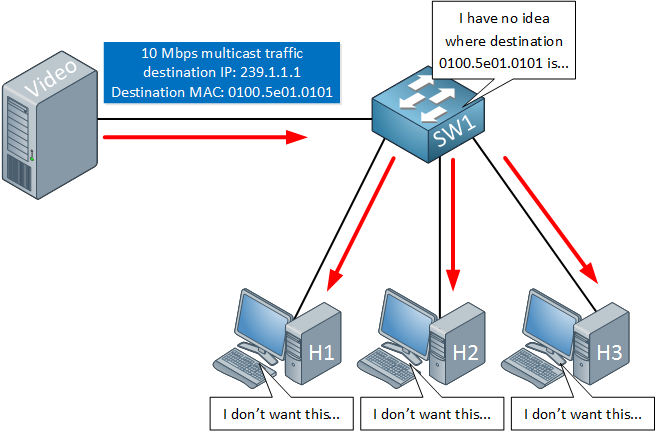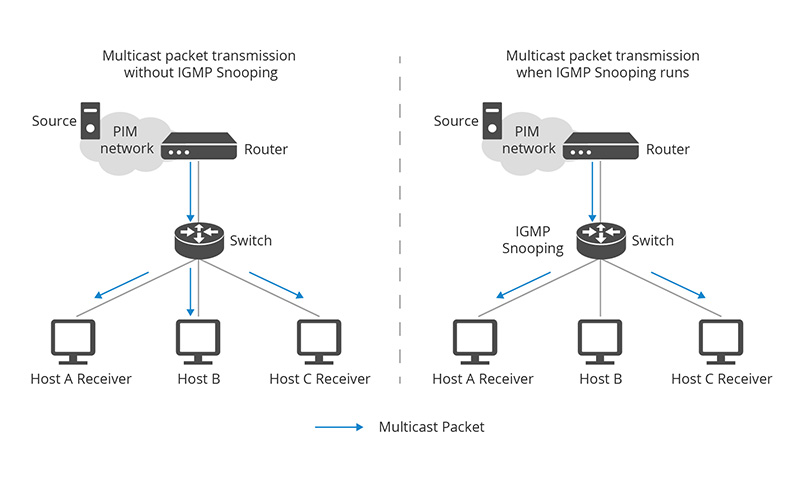
Are you experiencing high network traffic and low bandwidth and speed? It’s normal, but that doesn’t mean you can fix it. With IGMP snooping, you can prevent traffic floods, increase bandwidth, and improve network speed and performance. Here’s all you need to know about IGMP snooping and its uses.
Table of Contents
What Is IGMP Snooping?
IGMP stands for Internet Group Management Protocol; it’s a network layer. IGMP snooping refers to the process of listening to the IGMP network traffic and controlling the delivery of IP multicasts accordingly. Network switches use IGMP snooping to access the IGMP conversation between routers and hosts while maintaining the link with IP multicast transmission.
Network switches play a vital role in snooping. A network switch enables devices to connect with each other within a network and share data packets. Please note that these switches don’t transfer data between networks.
Layers of the Internet
As discussed, IGMP is a network layer. Therefore, it’s essential to understand what a network layer is. Before delving into what a network layer is, let’s discuss how the internet works.
The internet is divided into multiple layers, depending on the model in use. The OSI model is one of the standard models of the internet that comprises seven layers:
- Application layer
- Presentation layer
- Session layer
- Transport layer
- Network layer
- Data link layer
- Physical layer
Here, each layer has a different function. For example, the application layer facilitates human-computer interaction, the presentation layer ensures data usability, and the session layer maintains connections. The transport layer transmits data; the network layer determines the physical path the data will take, the data link layer defines the data format, and the physical layer transmits data.
Physical equipment and networking protocols are defined by their layer. Their layers determine their functions and how they interact with other layers, protocols, and equipment. For instance, a layer two switch cannot interact with a protocol in another layer.
IGMP snooping eliminates this limitation. It enables switches and routers in one layer to interact with networks in another layer. You can leverage this visibility to track multicast groups.
Benefits of IGMP Snooping
There are several benefits of using IGMP snooping, such as:
- Prevention of Traffic Floods: With IGMP, a switch becomes aware of the devices belonging to multicast groups. Many devices on the network have more traffic than needed. As a result, they utilize computing power to manage this increased load, which slows down their function, or worse, stops them entirely.
- Make Network Faster: A network that experiences more traffic has less bandwidth, and thus, becomes slower. IGMP snooping enables a network to reduce the amount of incoming traffic, thereby conserving bandwidth. A higher bandwidth makes the network faster.
- Better Network Health and Performance: With reduced traffic and a faster network, IGMP snooping helps enhance your network’s performance. This is helpful for enterprises that rely primarily on the internet for their operations.
Standard Status and Implementation Options
Though snooping is a crucial technique, it contradicts a couple of industry-standard organizations. The first is the Indian Institute of Electrical and Electronics Engineering (IEEE) which standardizes the use of Ethernet switches. The second is the Internet Engineering Task Force (IETF), which standardizes the usage of IP multicast.
So, IGMP has two implementation options:
IGMP Querier
A multicast router needs to be on the network and create queries for snooping to function. There needs to be a querier for IGMP membership reporting to work. In the absence of a querier, multicast groups and member ports will remain incomplete. In fact, you’ll need full querier capability for some IGMP implementations.
If you’re not certain which querier to select, you can refer to IGMPv2 and IGMPv3. The lowest IP address is the criteria for selection.
Proxy Reporting
The second IGMP snooping implementation option is proxy reporting. IGMP snooping with report suppression or proxy reporting allows you to filter IGMP packets and reduce the load on the router.
Things to Consider about IGMP Configurations
By this time, you have likely understood that IGMP enables multilayer communication and multicast forwarding. However, there are a few things you need to consider before implementing IGMP snooping functions. Here are a few things to keep in mind.
IGMP Snooping Version
IGMP comes in three protocol versions: V1, V2, and V3. Based on the IGMP version, you need to choose the IGMP snooping version. The IGMP version and IGMP snooping version need to be the same in order to process the messages between devices.
So, here’s how each IGMP version works:
- IGMPv1: To identify queried routers depending on the multicast routing protocol
- IGMPv2: Adding the capability of group queries, so the querier can send host messages
- IGMPv3: To improve source filtering (support-specific)
IGMP Snooping Querier
We discussed in the previous section about implementing snooping querier and proxy. If you want to enable snooping, you’ll need to implement a multicast router in the network topology. So, doing that will generate network queries and send them on timed intervals, facilitating IGMP snooping.
IGMP Snooping Proxy
Finally, let’s talk about IGMP proxy. The proxy has an additional function. When you enable the proxy, the snooping switch works the same way as the proxy. However, there’s a difference when the switch gathers a query from the router. When it collects the query, it sends back a report based on its status.
Now, you must be wondering what would happen if you disable this proxy. In that case, your VLAN will experience an influx of IGMP queries. This sudden rise in queries can affect the network performance. Hence, installing a proxy prevents a flood of queries and allows your network to handle traffic better.
Wrap Up
Many companies and individual users use IGMP to maintain network health and speed up networks. It makes the use of multicast layers to deviate traffic, increase bandwidth, and improve speed. However, be sure to keep version, proxy, and querier considerations in mind.
So, do you use snooping? If not, now is the right time.
RELATED ARTICLES
Latest Articles
 The Strategic Value of Purchasing FontsIn TipsApril 18, 2024In today’s visually driven world, fonts are more […]
The Strategic Value of Purchasing FontsIn TipsApril 18, 2024In today’s visually driven world, fonts are more […] Revolutionizing Business: How AI Transforms Customer Experience in the Inflatable IndustryIn BusinessApril 16, 2024Inflatable water slides are the epitome of summer fun, […]
Revolutionizing Business: How AI Transforms Customer Experience in the Inflatable IndustryIn BusinessApril 16, 2024Inflatable water slides are the epitome of summer fun, […] Most Asked Microservice Interview Questions For 2024In TechnologyApril 2, 2024To keep up with changing trends in the tech industry […]
Most Asked Microservice Interview Questions For 2024In TechnologyApril 2, 2024To keep up with changing trends in the tech industry […] Best JavaScript and CSS Library In 2024In TechnologyApril 2, 2024With the ever-expanding functionality of web […]
Best JavaScript and CSS Library In 2024In TechnologyApril 2, 2024With the ever-expanding functionality of web […] Front-End Development Trends to Follow in 2024In TechnologyApril 2, 2024For better engagement, the front-end development of […]
Front-End Development Trends to Follow in 2024In TechnologyApril 2, 2024For better engagement, the front-end development of […] Simplifying Mealtime: Meal Prepping for a Family of FourIn UncategorizedMarch 22, 2024In the hustle and bustle of daily life, planning and […]
Simplifying Mealtime: Meal Prepping for a Family of FourIn UncategorizedMarch 22, 2024In the hustle and bustle of daily life, planning and […] How to Freeze Dry Candy With And Without a Machine?In FoodFebruary 27, 2024A candy lover constantly searches for novel and […]
How to Freeze Dry Candy With And Without a Machine?In FoodFebruary 27, 2024A candy lover constantly searches for novel and […] How to Get Something Out Of Your Eye Immediately?In healthFebruary 27, 2024Getting something inside your eyes can be frustrating […]
How to Get Something Out Of Your Eye Immediately?In healthFebruary 27, 2024Getting something inside your eyes can be frustrating […] The Evolution of Remote Control Technology: From RC Cars to DronesIn TechnologyFebruary 22, 2024Remote control technology has come a long way since […]
The Evolution of Remote Control Technology: From RC Cars to DronesIn TechnologyFebruary 22, 2024Remote control technology has come a long way since […] Unveiling the most popular carnival costumes: A colorful parade of creativityIn FashionFebruary 19, 2024In the world of festivities and merrymaking, few […]
Unveiling the most popular carnival costumes: A colorful parade of creativityIn FashionFebruary 19, 2024In the world of festivities and merrymaking, few […] Custom GPTs: The Next AI Opportunity for BusinessesIn Business, TechnologyFebruary 14, 2024The rise of artificial intelligence has transformed […]
Custom GPTs: The Next AI Opportunity for BusinessesIn Business, TechnologyFebruary 14, 2024The rise of artificial intelligence has transformed […] How to Get Rid of a Canker Sore in 24 Hours?In healthFebruary 13, 2024Canker sores are also called aphthous ulcers. They […]
How to Get Rid of a Canker Sore in 24 Hours?In healthFebruary 13, 2024Canker sores are also called aphthous ulcers. They […]
stopie.com is a participant in the Amazon Services LLC Associates Program, an affiliate advertising program designed to provide a means for sites to earn advertising fees by advertising and linking to Amazon.com.
Clicking on an Amazon link from stopie.com does not increase the cost of any item you purchase.
We will only ever link to Amazon products that we think our visitors may be interested in and appreciate learning more about.





